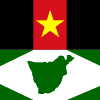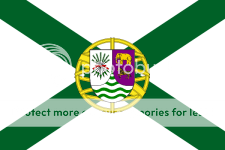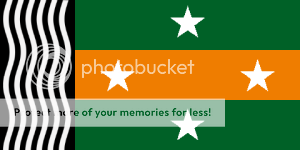[FONT="]Estêvão da Gama, inspired by Bartolomeu Diaz's reports about the Cape of Good Hope, devised a plan to establish a re-supply post there. He managed to convince King John II that such a colony would be necessary if Portugal wants to explore further eastwards to India.
The plan was put into action by the beginning of 1491. After Estêvão da Gama's landing there in May 6, 1491, with his 3 ships and 400-strong crew. The local Khoisan People were friendly and willing to trade, which allowed Estêvão to sail back home with 350 people, leaving behind 50 people in what would be known as São João's Town.
When he came back in two years, he brought along with him livestock, cereal, fruit seeds,iron axes/spearheads, a governor (Álvaro Caminha), and some prisoners as well as expelled Jews from Spain. There he found the original São João's Town well and sound, with the inhabitants intermarried with the locals.
[/FONT]
[FONT="]
[/FONT]
[FONT="]Flag of Sao Joao
[/FONT]
[FONT="]
[/FONT]
[FONT="] The town gradually grew as a supply post as Estêvão's son Visco da Gama inaugurated Portugal's spice trade with India. Subsequent Portuguese expeditions into Africa had always been São João based, Portugal set up a string of trade towns along the coast of OTL Angola, Namibia, South Africa, Mozambique and Madagascar, and gradually seeped into the inland.[/FONT]
[FONT="][/FONT]
[FONT="]Flag of the Crowned Prince as Prince of South Africa[/FONT]
[FONT="]
[/FONT]
[FONT="] Upset by Portugal's successes in the east, Spain behaved more jingoistic in Western Hemisphere, forcing Portugal to invest more into Africa. Portuguese Royalty's flee to Southern Africa during the Napoleonic Wars further strengthened Portuguese ties with the colony. This was helped by the liberal attitudes of Portuguese Viceroy Pedro, who supposedly said:”[/FONT] [FONT="]I know that my blood is the same colour as that of the Negroes.”[/FONT]
[FONT="][/FONT]
[FONT="]Flag of the Kingdom of Portugal and South Africa
[/FONT]
[FONT="]However, the just like enlightenment ideas of Tsarina Catherine the Great, Pedro’s liberal ideas had limited influences on real policies, and sadly, the realities of Portuguese rule remained similar to the hybrid of Spanish colonies in Americas and British India: Influential land-owning European feudal lords ruling over a Half-European, Half-Khoisan(or half Bantu) peasant/farm workers’ class, with semi-independent black princedoms paying tribute to it. There were, however, more churches, more schools and hospitals than other European colonies. This ensured the half of the natives and almost all of the European immigrants to be Portugalized.
[/FONT]
[FONT="]
[/FONT]
[FONT="]In the late 1800s and early 1900s, the reactionary land-owning class of South Africa was more and more connected with British and American bankers, who influenced Sao Joao more intensively than Lisbon does.
[/FONT]
[FONT="]
[/FONT]
[FONT="]When Constitutional Revolution broke out in Portugal, the upper class (and their friends in London and Wall Street) felt threatened by its liberal ideals, they declared for themselves the “Republic of South Africa”, though people preferred to add the word “Banana” before its title.
[/FONT]
Flag of the "Banana" Republic.
[FONT="][/FONT]
[FONT="]
[/FONT]
[FONT="]However, changes in Mainland Portugal and their colonies still influenced South Africa, who never developed something as rigid and ideological as the OTL apartheid. In addition, the more “black” eastern regions of the country, without having a plantation-dominated economy, gradually Industrialised under foreign investments in labour-intensive industries. These positive economic changes paved way for gradual political change.
[/FONT]
[FONT="]
[/FONT]
[FONT="]And finally, when radical priests lead a revolution in 1980, the country adopted a new flag, with red symbolising different races of the country having the same colour in their blood, white for a new “clean” government, echoing Pedro’s words, white disk symbolising national integrity, white cross in the background for trading routes which enriches the strategically–placed country, and an Order of Christ Cross in the centre symbolising Christianity.[/FONT]
[FONT="]
[/FONT]
[FONT="]Flag of the Republic of South Africa.
[/FONT]
[FONT="]
[/FONT]










